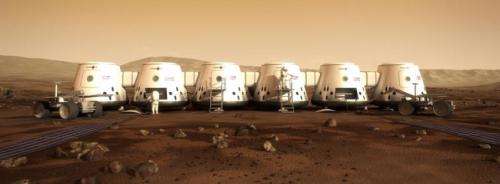October 14, 2014 weblog
Mars One: MIT study team looks before mankind leaps

Mars One is a not-for-profit foundation which has a mission to establish a human settlement on Mars. Starting in 2024, Mars One intends to set up a permanent human settlement on Mars. Crews of four will depart every two years, with the first unmanned mission coming up in 2018. The team behind Mars One considers this "The Next Giant Leap for Mankind."
Students at MIT looked at the pending leap. They presented their 35-page paper recently at the 65th International Astronautical Congress, in Toronto. Their paper, "An Independent Assessment of the Technical Feasibility of the Mars One Mission Plan," is by Sydney Do, Koki Ho, Samuel Schreiner, Andrew Owens and Olivier de Weck. Their work was supported by NASA grants and the Josephine de Karman Fellowship Trust.
"As the Mars One mission plan represents a dramatic departure from more conservative exploration approaches, there are many uncertainties in the mission design," they wrote in their paper. "Because no information regarding the Mars One mission was found in the literature," they said, "mission architecture details are primarily derived from the Mars One website, as well as the request for proposals and the proposal information package for the 2018 Mars Lander payload." One of the concerns they raised was that "our habitation simulations revealed that crop growth, if large enough to provide 100 percent of the settlement's food, will produce unsafe oxygen levels in the habitat. As a result, some form of oxygen removal system is required – a technology that has not yet been developed for spaceflight." Jeffrey Kluger provided a translation in TIME.com: "The biggest problem, the students discovered, concerns that business of breathable air." The authors made a point of saying in the paper that their overall analysis "was based on the best available information available to them on the missions and technologies proposed. Should updated information become available, the authors would gladly update this analysis."
An open letter on their work presented in Toronto was then posted on the MIT Strategic Engineering Research Group site. The team said to do their study, they created "an integrated model of a Mars habitat, capturing life support and in-situ resource utilization technologies, their sparing requirements, and the transportation system required to get this equipment to Mars. This model was based as much as possible on data posted on the Mars One website and, where data was not available, current state of the art technology." The open letter highlighted their findings—including the cost of the mission, and growing food on Mars versus carrying food from Earth.
Regarding the cost of the mission, they said in the open letter that the cost of the Mars One mission increases over time due to the increasing spares requirement - as the colony grows, more systems are required, in turn necessitating more spare parts and therefore more rocket launches.
As for growing food on Mars, they said in the open letter that "If all food is sourced from plants, excessive oxygen will need to be managed. While there is technology available on Earth to handle this, no such technology has been developed for spaceflight. This issue is removed if food is transported from Earth rather than grown locally."
Graduate student Sydney Do said in MIT News on Tuesday that, when exploring solutions, the group found that the cheapest option was to supply all food required from Earth. "We found carrying food is always cheaper than growing it locally," he told MIT News. "On Mars, you need lighting and watering systems, and for lighting, we found it requires 875 LED systems, which fail over time. So you need to provide spare parts for that, making the initial system heavier."
Overall, Olivier de Weck, an MIT professor of aeronautics and astronautics and engineering systems, said in MIT News, "We're not saying, black and white, Mars One is infeasible." Nonetheless, they think that "it's not really feasible under the assumptions they've made," he added. "We're pointing to technologies that could be helpful to invest in with high priority, to move them along the feasibility path."
Mars One CEO Bas Lansdorp said in Popular Science that he has talked to "very knowledgeable people—experts with companies like Lockheed Martin—who tell me these technologies will work."
The Mars One FAQ page addresses the question, is this a sustainable mission: "Solar panels can generate all of the settlement's energy with only sunlight as fuel. The base will also recycle as much as they can to avoid more resources having to be sent from Earth or having to delve for more in the local air and soil." When it comes to provisions, their independence will increase steadily, starting with their own production of oxygen and water when they land. The first four will also be carrying a device similar to a portable greenhouse, that will allow them to grow their own food, according to the FAQ list. "As more astronauts start arriving it will become necessary for them to manufacture certain supplies themselves, rather than relying on Earth. Two examples are: A method to construct additional living area. A machine that makes plastic, so they can create plastic products or foils."
More information: web.mit.edu/sydneydo/Public/Mars%20One%20Feasibility%20Analysis%20IAC14.pdf
© 2014 Tech Xplore




















